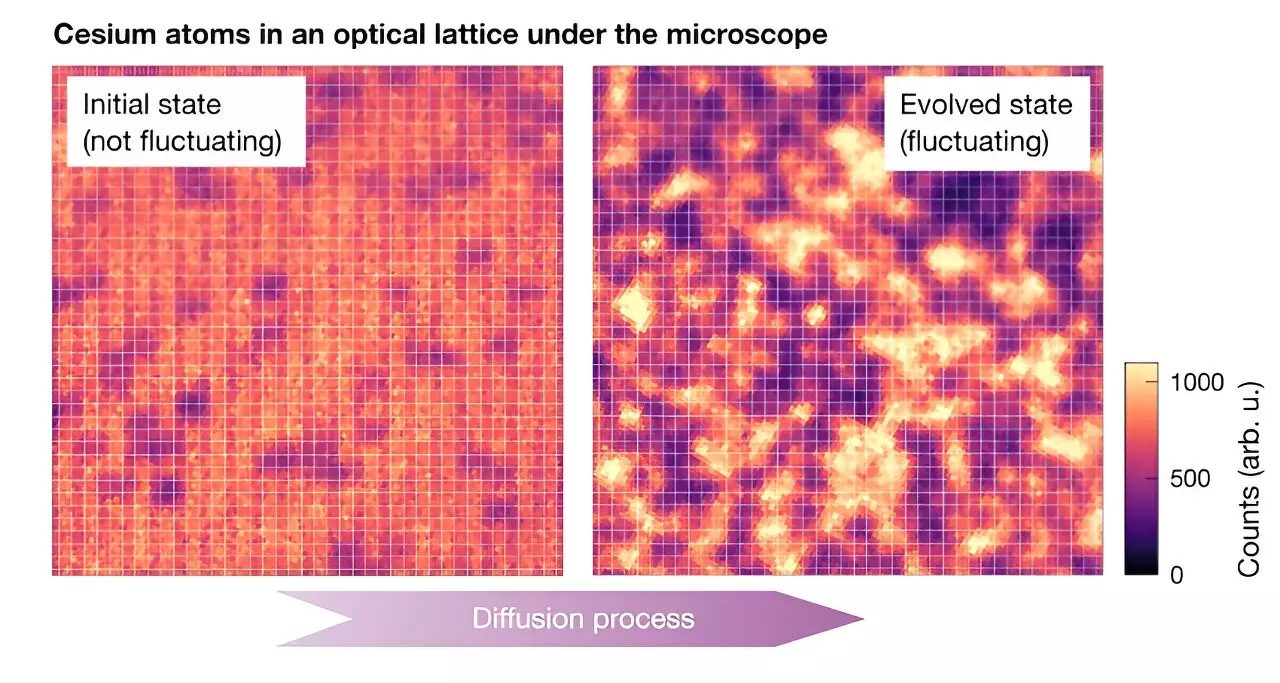In the realm of quantum mechanics, the behavior of particles often seems counterintuitive. Unlike classical systems, which can often be anticipated with a fair degree of certainty, quantum systems are governed by complex rules that allow particles to exist in multiple states or positions simultaneously. A recent study by a collaborative team of researchers from Ludwig-Maximilians-Universität, Max-Planck-Institut für Quantenoptik, and the University of Massachusetts has opened a new avenue in our understanding of these systems. Their research, published in *Nature Physics*, investigates the equilibrium fluctuations that occur in large quantum systems using advanced experimental techniques, specifically a quantum gas microscope.
Predicting the behavior of quantum systems over time can be daunting due to the sheer number of variables involved. As Julian Wienand, a co-author of the study, articulates, the theoretical framework for simulating these systems often falters because of the enormous computational resources required to track the myriad interactions between individual particles. To conceptualize this, consider a box filled with countless particles. In theory, one could create a comprehensive simulation by programming the behavior of each particle. However, such an undertaking quickly becomes infeasible as the number of particles grows, prompting researchers to seek alternative strategies.
One promising solution utilizes hydrodynamics, a branch of physics that deals with the motion of fluids and gases. Through the lens of hydrodynamics, particle interactions can be simplified, allowing scientists to depict these interactions as a continuous density field governed by differential equations. This approach alleviates the computational burden, allowing for a macroscopic description of the system without losing sight of key variables.
Wienand’s team introduced an innovative adaptation of classical hydrodynamics termed fluctuating hydrodynamics (FHD). By integrating the effects of small-scale fluctuations—similar to white noise—into their equations, they optimized the prediction of system behavior at larger scales. In essence, FHD grants physicists the ability to account for rapid, random movements of particles, which can significantly influence the broader dynamics of the system.
Interestingly, while classical systems often reveal predictable patterns, quantum systems exhibit unique features, such as entanglement, that challenge conventional understanding. This distinction raises questions regarding the applicability of FHD in chaotic quantum contexts. The study aims to bridge this gap, suggesting that despite the inherently complex nature of quantum mechanics, it may be possible to reduce the understanding of chaotic quantum systems to a few essential quantities, such as a diffusion constant.
Utilizing a cesium (133Cs) quantum gas microscope, the researchers designed a series of experiments to monitor quantum interactions closely. The team executed these experiments by trapping ultracold cesium atoms in an optical lattice created from laser light. This experimental framework enabled real-time observation of the atomic interactions, establishing a vital connection between theory and practice. The microscope allowed for unprecedented spatial resolution, providing clarity in the occupancy of lattice sites and permitting precise measurements of fluctuations in atom counts.
Initially, the atoms were organized in a structured state; however, an abrupt reduction in the lattice depth triggered mobility among the atoms, leading to a diffusion-like thermalization process. By meticulously tracking fluctuations during this transition, the researchers could assess the growth rate of these fluctuations against theoretical predictions, ultimately validating the effectiveness of FHD in describing the system’s behavior.
The team’s findings herald a significant milestone in quantum physics, demonstrating that classical modelling frameworks like FHD can also effectively describe chaotic quantum systems both qualitatively and quantitatively. This revelation is monumental because it suggests that there exists a fundamental simplicity in macroscopic behaviors, even when the underlying quantum mechanics are intricate and chaotic.
Moreover, the equilibrium properties of the systems being studied pose intriguing questions. Despite measurements being taken when the quantum many-body system is out of equilibrium, FHD establishes correlations between equilibrium and non-equilibrium states. This insight presents a fresh perspective on how diffusion constants can be derived from a quantum framework, paving the way for further exploration in future studies.
Ultimately, the ongoing work of Wienand and his collaborators promises to delve deeper into the dynamics of quantum many-body mechanics. They plan to address critical questions regarding systems that do not reach thermal equilibrium and explore higher moments of fluctuations. As this research progresses, it may yield valuable insights into quantum phenomena, further enhancing our understanding of the complexities inherent in nature.
The study of fluctuating dynamics in quantum systems has significant implications for both theoretical and experimental physics. Through innovative methods and collaboration, researchers have demonstrated the potential for classical frameworks to elucidate quantum complexities, bridging the gap between theory and experimental validation. As the boundary between classical and quantum worlds continues to blur, the findings of this research stand as a testament to the intricate, yet accessible nature of quantum behavior, promising a wealth of discovery for the scientific community.


Leave a Reply